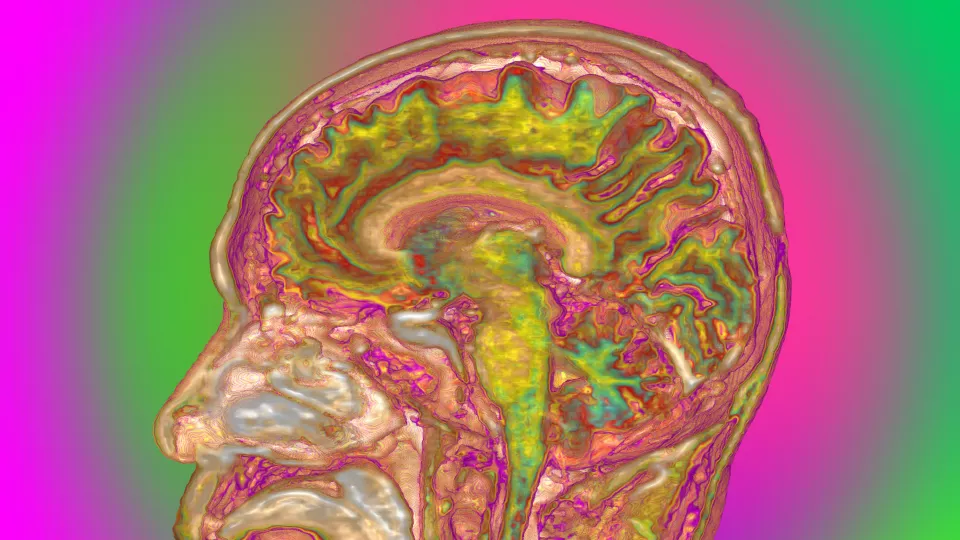Alzheimer’s disease gains a foothold when brain cells suddenly begin to wither away and die faster than normal. It is a disease that makes it increasing difficult to cope, even with the ingrained activities of everyday life. Slowly, changes occur in language and the perception of time, and hallucinations and anxiety can also arise. Finally, the Alzheimer’s sufferer disappears in the fog and perhaps can no longer recognise their wife, husband or children.
“It’s a horrible disease and that could be the reason why I have chosen it as the subject for my research. Alzheimer’s disease has not been prioritised very much by society. It’s almost as if people think it’s normal to age in this way, to be senile and old. But, of course it’s not, it’s actually a serious disease”, emphasises Oskar Hansson.
No one knows why nerve cell death occurs in the brain. However, Oskar Hansson and his colleagues have shown in earlier studies that is possible, as early as 10 to 20 years before the disease manifests, to see the first signs of morbidity in the brain’s interior parts, in what is known as the default mode network. It is one of the most highly developed networks in the brain and shows signs of most intense activity when we daydream.
“Now that we know where the earliest signs of Alzheimer’s disease arise in the brain, we can focus on it and investigate these parts further in order to understand what lies behind the disease”, states Oskar Hansson.
Oskar Hansson had already started to conduct research on biomarkers in cerebrospinal fluid while he was studying to become a doctor. He and his colleagues concluded that certain markers could predict memory problems that in a later stage could lead to Alzheimer’s disease. And what happens in the brain is reflected in the cerebrospinal fluid.
“It was a revolutionary discovery”, says Oskar Hansson. “Today, we can make much more reliable diagnoses, even for those who seek help for mild memory problems. All those who seek help at a memory clinic will be offered a cerebrospinal fluid analysis. In this way, you can get the right information faster and we can apply disease-modifying drugs. Symptom-relieving medicines have most benefit if they are applied at an early stage. Memory will improve, but the disease will still run its course.”
In his research, Oskar Hansson has also found that two biomarkers, the two proteins beta- amyloid and tau, lie behind the risks of developing Alzheimer’s disease. Beta-amyloid can begin to accumulate two decades earlier in the brain, but it is only when tau begins to appear that nerve cells start dying and memory begins to falter. Using new techniques in which cerebrospinal fluid analysis is combined with advanced imaging technology, it is possible to get closer to answering why nerve cells die and what can be done to prevent it.
So, yes – mental activity provides some protection.
It is feared that the number of people who develop Alzheimer’s disease globally will triple in the years 2010 to 2050, as there will be better living standards in low and middle-income countries and people will consequently live longer.
“It’s an enormous increase, from 40 million to 120 million. But, how are we going to take care of all these people? If we look at costs solely in Sweden it amounts to SEK 50 to 60 billion annually. That is more than the combined costs for cancer, stroke and cardiovascular diseases”, stresses Oskar Hansson.
It becomes expensive for municipalities when people lose the capacity to look after themselves and need to stay in a special dementia facility with staff providing round-the-clock care. And how will the countries that have an accelerating increase in the disease choose to take care of sufferers? Are families to provide care in order to keep down costs? These are some of the issues that Oskar Hansson wonders about.
Neurologist and researcher Oskar Hansson, one of Sweden’s leadings figures in Alzheimer’s research
Who develops dementia and why? Usually, people do not develop the disease before the age of 55, and if they do it is most often an inherited form of Alzheimer’s. However, most people develop the disease later in life.
“When we have measured nationally and internationally, we see that those people who have a longer education have stronger protection against the disease. So, yes – mental activity provides some protection”, explains Oskar Hansson and continues:
“In exactly the same way as we build up muscles by training, we can exercise our brains to resist Alzheimer’s disease.”
At present, there are no medicines that stop the course of the disease, and international pharmaceutical companies are investing heavily to develop antibodies against beta-amyloid and tau, which hopefully can prevent Alzheimer’s disease. Oskar Hansson and his research colleagues would like to help and investigate whether the antibodies do what they are supposed to do. However, Oskar Hansson considers that many pharmaceutical studies are carried out too late in the course of the disease, when a large number of the nerve cells have already died.
“It’s like trying to reverse a very serious heart failure – it’s difficult. We need to know more about the disease and as our work involves human subject studies, we believe we can develop relevant tools in order to see which people with mild memory problems have the beginnings of Alzheimer’s disease. In order to learn more, we are analysing healthy elderly people of which around 20 per cent have incipient Alzheimer’s disease, but do not as yet have symptoms.”
Oskar Hansson works for two days each month at the Memory Clinic at SUS in Malmö. He considers that it is not enough. As head of the department, he meets patients and their relatives.
“The days I feel best are the days when I have patients. It’s very satisfying to be able to investigate, diagnose and offer different types of treatment methods. Even though Alzheimer’s disease is difficult to diagnose, we have come an incredibly long way regarding diagnosis. Now, we need to find anti-retroviral drugs that stop the disease completely.”

